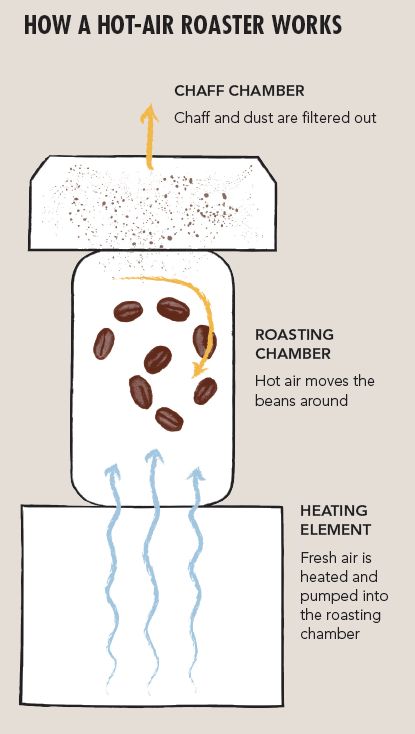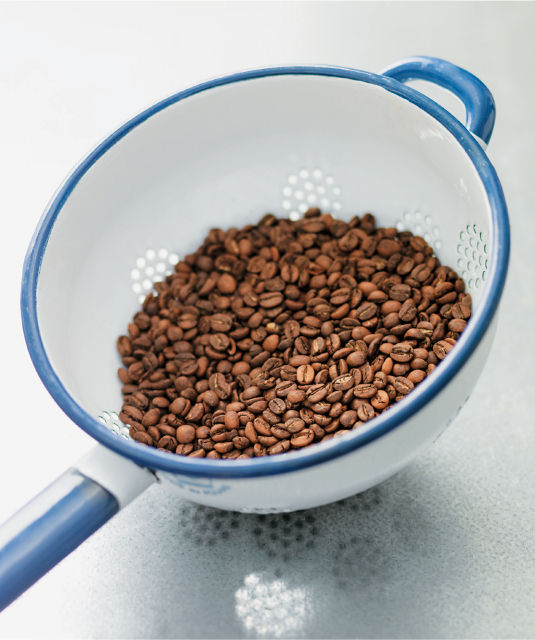In the past, it was not uncommon for a household to buy raw coffee and roast it at home. Since the mid-20th century, however, the trend has undeniably favoured convenience. Roasting coffee at home is fun and relatively inexpensive, although it is a considerable challenge to achieve the same quality of roasted coffee as the very best commercial roasters.
Home roasting allows you to roast smaller batches of raw coffees than you might be able to buy roasted, so you can explore a greater number of green coffees and learn as you go. Like any hobby, there will probably be terrible failures and surprise successes along the way. It is important to consider roasting coffee as a new hobby, not as a way to save money on buying roasted coffee beans. The time invested, as well as the equipment, means that you should be enjoying the time spent roasting and learning, rather than seeing it as a chore.
An increasing numbers of companies are selling green coffee online. While raw coffee does have a longer shelf life than roasted coffee, I would caution against buying in bulk. Raw coffee does fade over time, and you’d certainly want to use any beans you buy within 3–6 months.
When it comes to selecting raw coffees, I’d recommend making sure what you’re buying is genuinely traceable (see sections on individual countries for guidance). I’d also recommend occasionally buying green coffee from a company that sells the same coffee roasted. This will allow you to benchmark your own roasting by comparing your roasted beans with the commercially roasted beans to see how you are progressing.
HOME-ROASTING MACHINES
It is possible to roast coffee in almost anything that generates enough heat: you can put raw coffee on a baking sheet and bake it in the oven until browned, but the results will be pretty terrible. The coffee will be unevenly roasted, and the part of the coffee in contact with the tray may be scorched. Roasting this way highlights the need for the movement and agitation of coffee beans during the roasting process, to get an even result. Roasting coffee in a wok is possible, but the amount of stirring required quickly makes the process tiresome and frustrating.
Many people start out with something a bit more sophisticated, like using a heat gun and agitating the coffee beans regularly as they roast, or using a modified electric popcorn machine. Second-hand popcorn machines can be acquired cheaply and do a reasonable job of roasting coffee: they will usually roast a small batch of coffee quite quickly – in around four or five minutes – but they don’t do a great job of producing even results at lighter roasts. People who prefer darker, more developed roasts seem to have more success with them. Bear in mind that this is not the use these machines were designed for, and some models may not have enough power to roast coffee properly.
If you really want to roast coffee at home successfully, you will need a machine specifically designed for the purpose. Start small and decide if you enjoy the ritual, the regularity of it and the overall process. Starting this way is easy and fun, and there is no regret if you decide you would rather leave this part of the process to the professionals.
There are two main types of machine available to the home roaster: hot-air roasters and drum roasters.
HOT-AIR ROASTERS
Hot-air roasters mimic, on a much smaller scale, commercial fluid-bed roasters (see Types of Coffee Roasters). They work rather like powerful popcorn poppers: the hot air agitates and moves the beans around in the roasting chamber to produce an even roast, as well as providing the necessary heat to turn them brown. You have some level of control over the amount of heat and the fan speed, so you can speed up or slow down the process as necessary. Cheaper than drum roasters, these machines are a great starting point for someone looking to dip a toe in the home roasting process.
Some machines do a better job than others of dealing with the smoke and smells produced during roasting, but I would still recommend roasting in a well-ventilated area. However, if you roast outside and it is very cold, roasting times may be slower than you want.

THE PERFECT ROAST
Ideally, a roast in a hot-air roaster should last for eight to twelve minutes. Drum roasts tend to be a little slower, more like ten to fifteen minutes, depending on the size of the batch of coffee. If the resulting coffee tastes very bitter, you may have roasted too dark. If it lacks flavours and sweetness, you may have roasted too slowly. If it tastes very sour, astringent and grassy, you have probably roasted the coffee too quickly. A combination of lots of tasting and a little trial and error is a healthy part of the process and will allow you to understand your own preferences more and more.
DRUM ROASTERS
Home drum roasters are similar in design to commercial drum roasters, but they are not built with the same quality and weight of materials. The coffee is tumbled around in a heated drum, which is designed to keep the beans moving to allow even browning.
Some drum machines offer more programming functions, allowing you to create your own roast profiles. The intensity of the heat can be varied throughout the roast, and the machine can automate the process to allow easy replication of your favourite roasts.
 Like any new hobby, roasting coffee beans at home will have some failures and surprise successes, but is worth trying if you want to experiment with tasting a range of green coffees.
Like any new hobby, roasting coffee beans at home will have some failures and surprise successes, but is worth trying if you want to experiment with tasting a range of green coffees.